Abstract
We and others have noted that there are serological differences between verotoxin 2 (VT2) (also known as Shiga-like toxin II) produced by Escherichia coli C600(933W) and the VT2 variant (VT2v) produced by strain E32511. Recent reports have described nucleotide sequence differences between the VT2v B subunit cistron of E32511 and B2F1 and that of VT2. We have confirmed the sequence differences and have used them to design oligonucleotide probes which differentiate the B subunit cistron of VT2v from that of VT2. Isolates of VT-producing E. coli obtained from human as well as food and veterinary sources were classified according to the toxin phenotype by using a toxin neutralization assay with VT2-specific monoclonal antibody and VT2v-specific polyclonal antisera. Using the oligonucleotide probes in colony hybridization, we detected 35 of 35 VT2 producers and 16 of 16 VT2v producers. One VT2 producer was falsely identified as containing the VT2v gene. The E32511 strain in our collection hybridized only with the VT2-specific probe. Southern hybridization of radiolabeled oligonucleotide probes showed that strains carried zero to one copy of the VT2 gene and zero to two copies of the VT2v gene. We conclude that colony hybridization with the VT2- and VT2-specific probes is highly predictive of the toxin phenotypes in the clinical isolates described in this study.
Full text
PDF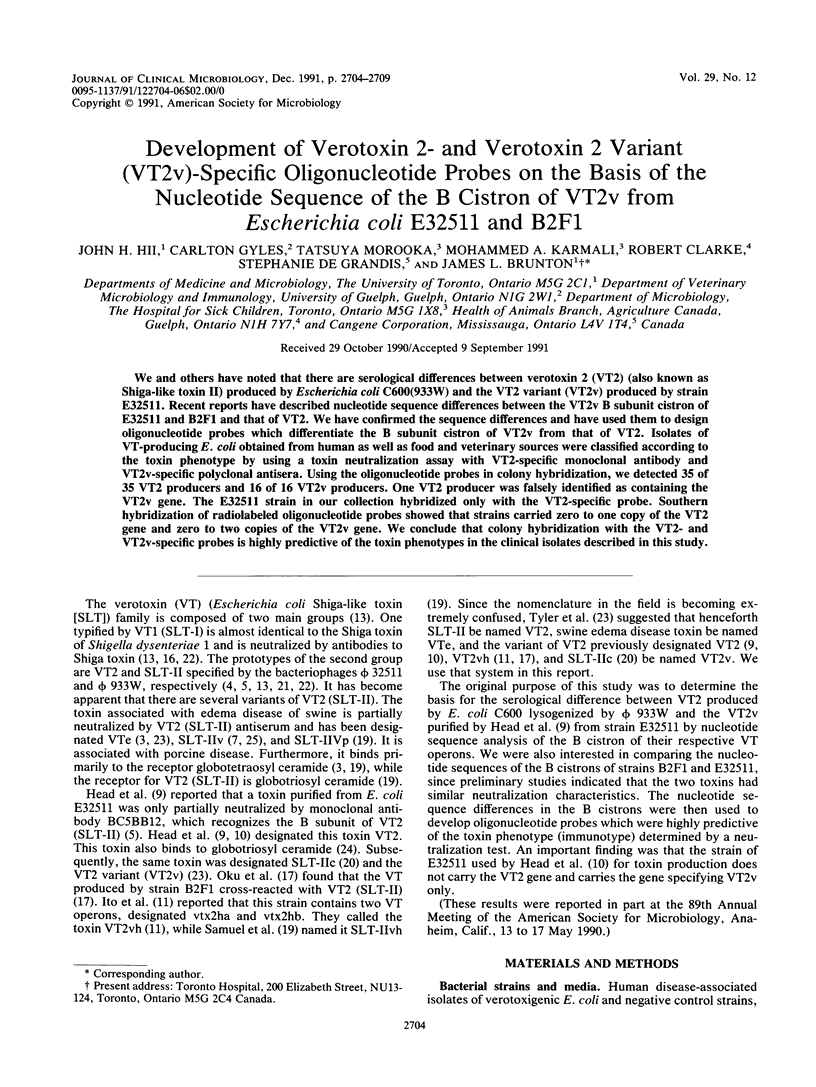
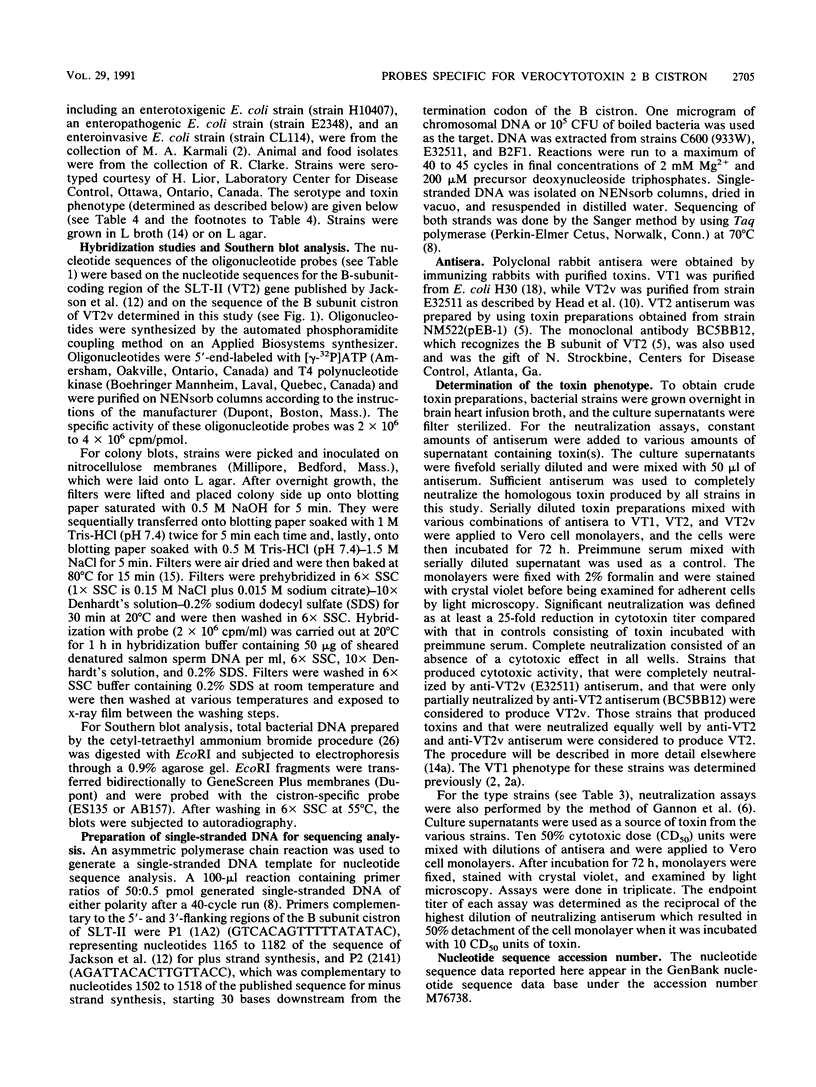
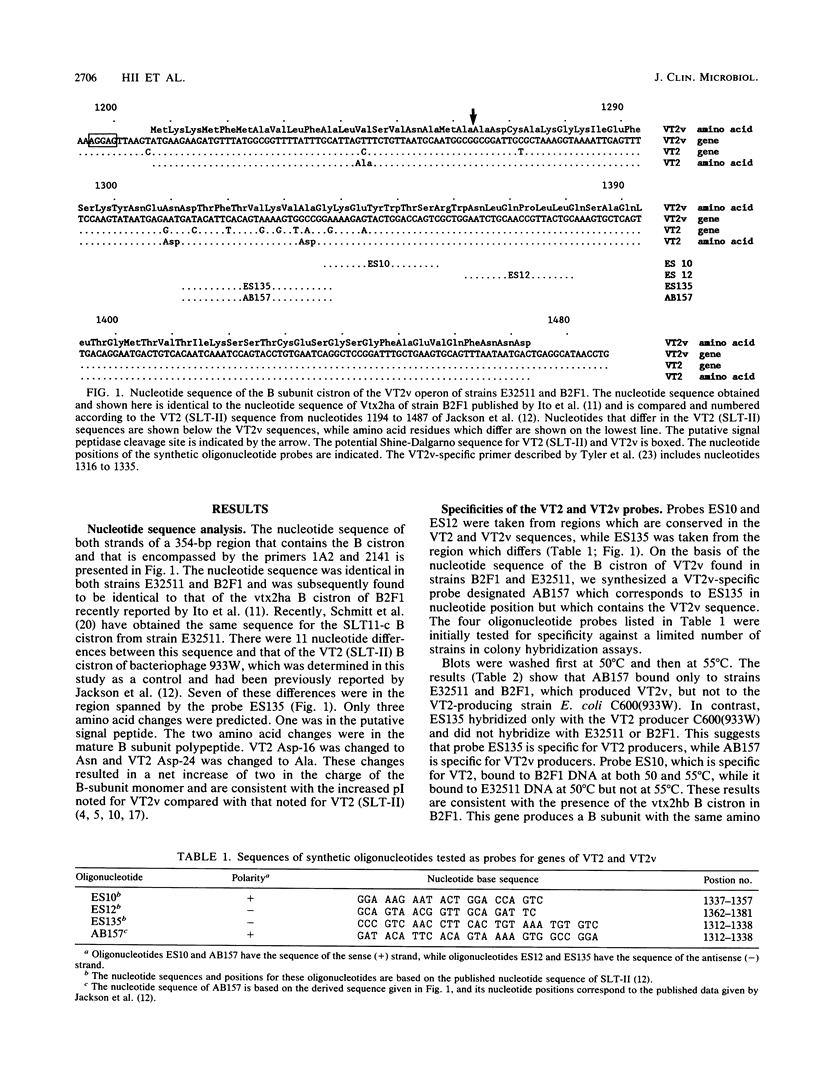
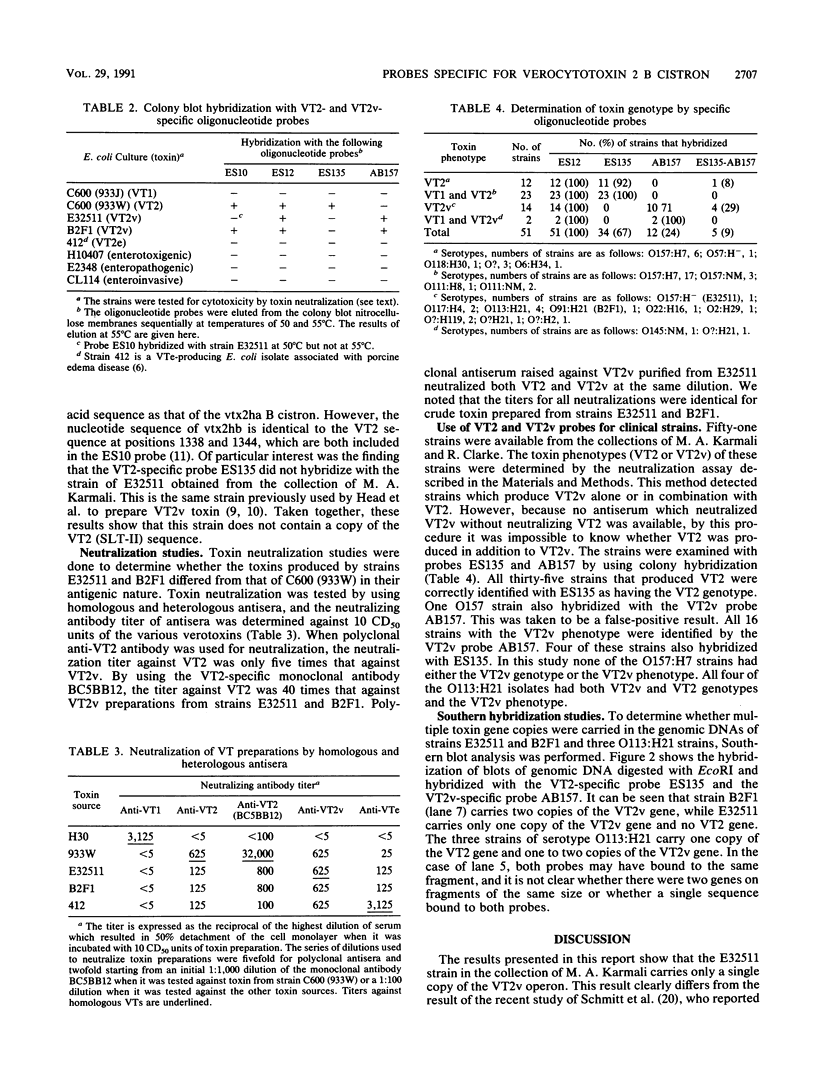
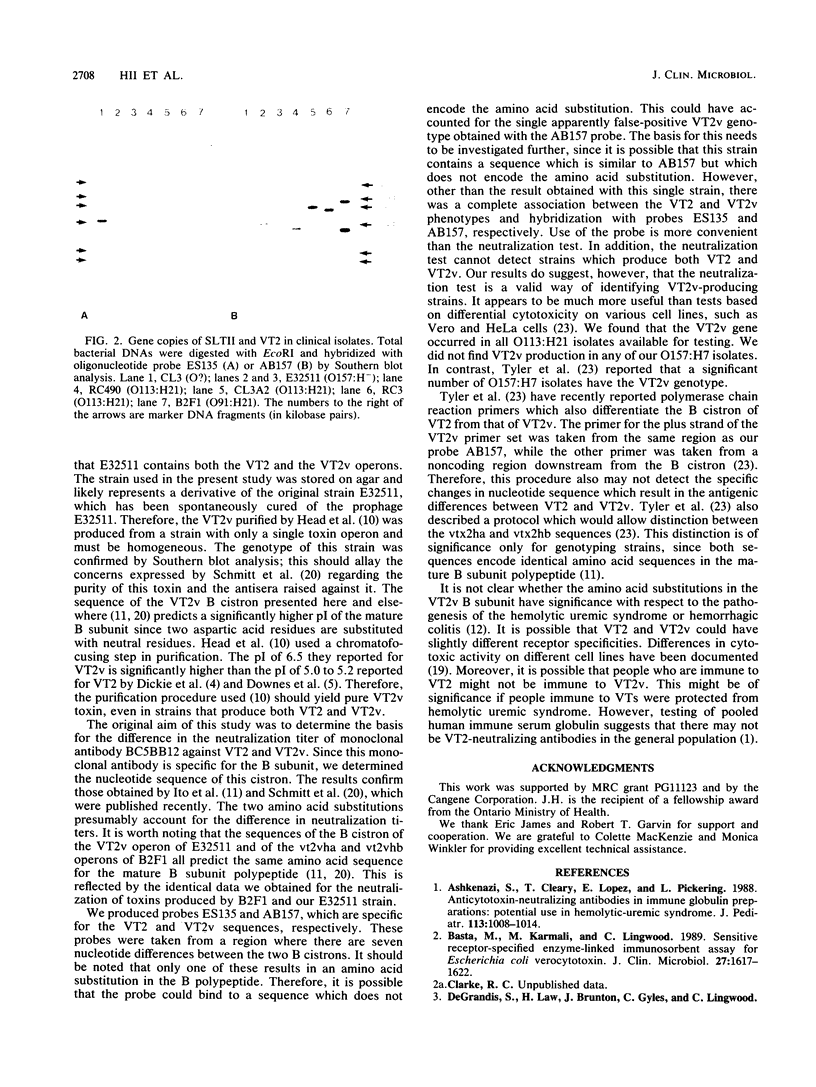
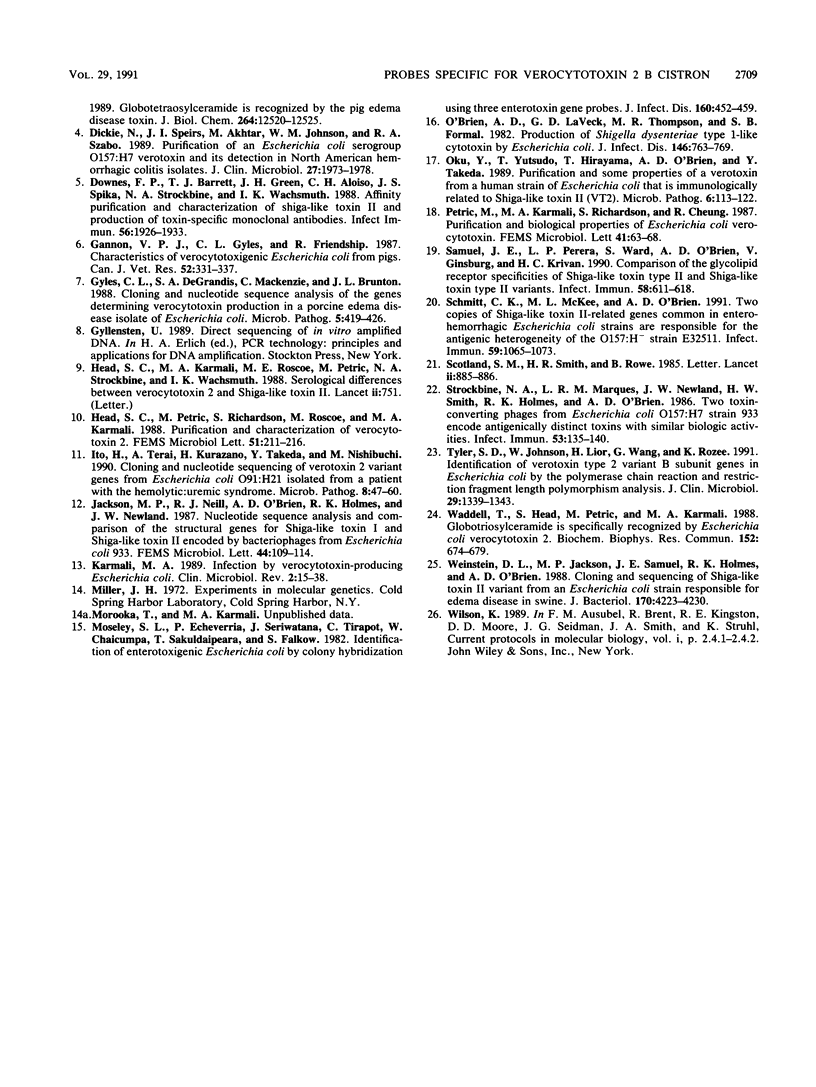
Images in this article
Selected References
These references are in PubMed. This may not be the complete list of references from this article.
- Ashkenazi S., Cleary T. G., Lopez E., Pickering L. K. Anticytotoxin-neutralizing antibodies in immune globulin preparations: potential use in hemolytic-uremic syndrome. J Pediatr. 1988 Dec;113(6):1008–1014. doi: 10.1016/s0022-3476(88)80572-9. [DOI] [PubMed] [Google Scholar]
- Basta M., Karmali M., Lingwood C. Sensitive receptor-specified enzyme-linked immunosorbent assay for Escherichia coli verocytotoxin. J Clin Microbiol. 1989 Jul;27(7):1617–1622. doi: 10.1128/jcm.27.7.1617-1622.1989. [DOI] [PMC free article] [PubMed] [Google Scholar]
- Dickie N., Speirs J. I., Akhtar M., Johnson W. M., Szabo R. A. Purification of an Escherichia coli serogroup O157:H7 verotoxin and its detection in North American hemorrhagic colitis isolates. J Clin Microbiol. 1989 Sep;27(9):1973–1978. doi: 10.1128/jcm.27.9.1973-1978.1989. [DOI] [PMC free article] [PubMed] [Google Scholar]
- Downes F. P., Barrett T. J., Green J. H., Aloisio C. H., Spika J. S., Strockbine N. A., Wachsmuth I. K. Affinity purification and characterization of Shiga-like toxin II and production of toxin-specific monoclonal antibodies. Infect Immun. 1988 Aug;56(8):1926–1933. doi: 10.1128/iai.56.8.1926-1933.1988. [DOI] [PMC free article] [PubMed] [Google Scholar]
- Gannon V. P., Gyles C. L., Friendship R. W. Characteristics of verotoxigenic Escherichia coli from pigs. Can J Vet Res. 1988 Jul;52(3):331–337. [PMC free article] [PubMed] [Google Scholar]
- Gyles C. L., De Grandis S. A., MacKenzie C., Brunton J. L. Cloning and nucleotide sequence analysis of the genes determining verocytotoxin production in a porcine edema disease isolate of Escherichia coli. Microb Pathog. 1988 Dec;5(6):419–426. doi: 10.1016/0882-4010(88)90003-4. [DOI] [PubMed] [Google Scholar]
- Head S. C., Karmali M. A., Roscoe M. E., Petric M., Strockbine N. A., Wachsmuth I. K. Serological differences between verocytotoxin 2 and shiga-like toxin II. Lancet. 1988 Sep 24;2(8613):751–751. doi: 10.1016/s0140-6736(88)90228-0. [DOI] [PubMed] [Google Scholar]
- Ito H., Terai A., Kurazono H., Takeda Y., Nishibuchi M. Cloning and nucleotide sequencing of Vero toxin 2 variant genes from Escherichia coli O91:H21 isolated from a patient with the hemolytic uremic syndrome. Microb Pathog. 1990 Jan;8(1):47–60. doi: 10.1016/0882-4010(90)90007-d. [DOI] [PubMed] [Google Scholar]
- Karmali M. A. Infection by verocytotoxin-producing Escherichia coli. Clin Microbiol Rev. 1989 Jan;2(1):15–38. doi: 10.1128/cmr.2.1.15. [DOI] [PMC free article] [PubMed] [Google Scholar]
- O'Brien A. D., LaVeck G. D., Thompson M. R., Formal S. B. Production of Shigella dysenteriae type 1-like cytotoxin by Escherichia coli. J Infect Dis. 1982 Dec;146(6):763–769. doi: 10.1093/infdis/146.6.763. [DOI] [PubMed] [Google Scholar]
- Oku Y., Yutsudo T., Hirayama T., O'Brien A. D., Takeda Y. Purification and some properties of a Vero toxin from a human strain of Escherichia coli that is immunologically related to Shiga-like toxin II (VT2). Microb Pathog. 1989 Feb;6(2):113–122. doi: 10.1016/0882-4010(89)90014-4. [DOI] [PubMed] [Google Scholar]
- Samuel J. E., Perera L. P., Ward S., O'Brien A. D., Ginsburg V., Krivan H. C. Comparison of the glycolipid receptor specificities of Shiga-like toxin type II and Shiga-like toxin type II variants. Infect Immun. 1990 Mar;58(3):611–618. doi: 10.1128/iai.58.3.611-618.1990. [DOI] [PMC free article] [PubMed] [Google Scholar]
- Schmitt C. K., McKee M. L., O'Brien A. D. Two copies of Shiga-like toxin II-related genes common in enterohemorrhagic Escherichia coli strains are responsible for the antigenic heterogeneity of the O157:H- strain E32511. Infect Immun. 1991 Mar;59(3):1065–1073. doi: 10.1128/iai.59.3.1065-1073.1991. [DOI] [PMC free article] [PubMed] [Google Scholar]
- Scotland S. M., Smith H. R., Rowe B. Two distinct toxins active on Vero cells from Escherichia coli O157. Lancet. 1985 Oct 19;2(8460):885–886. doi: 10.1016/s0140-6736(85)90146-1. [DOI] [PubMed] [Google Scholar]
- Strockbine N. A., Marques L. R., Newland J. W., Smith H. W., Holmes R. K., O'Brien A. D. Two toxin-converting phages from Escherichia coli O157:H7 strain 933 encode antigenically distinct toxins with similar biologic activities. Infect Immun. 1986 Jul;53(1):135–140. doi: 10.1128/iai.53.1.135-140.1986. [DOI] [PMC free article] [PubMed] [Google Scholar]
- Tyler S. D., Johnson W. M., Lior H., Wang G., Rozee K. R. Identification of verotoxin type 2 variant B subunit genes in Escherichia coli by the polymerase chain reaction and restriction fragment length polymorphism analysis. J Clin Microbiol. 1991 Jul;29(7):1339–1343. doi: 10.1128/jcm.29.7.1339-1343.1991. [DOI] [PMC free article] [PubMed] [Google Scholar]
- Waddell T., Head S., Petric M., Cohen A., Lingwood C. Globotriosyl ceramide is specifically recognized by the Escherichia coli verocytotoxin 2. Biochem Biophys Res Commun. 1988 Apr 29;152(2):674–679. doi: 10.1016/s0006-291x(88)80091-3. [DOI] [PubMed] [Google Scholar]
- Weinstein D. L., Jackson M. P., Samuel J. E., Holmes R. K., O'Brien A. D. Cloning and sequencing of a Shiga-like toxin type II variant from Escherichia coli strain responsible for edema disease of swine. J Bacteriol. 1988 Sep;170(9):4223–4230. doi: 10.1128/jb.170.9.4223-4230.1988. [DOI] [PMC free article] [PubMed] [Google Scholar]



